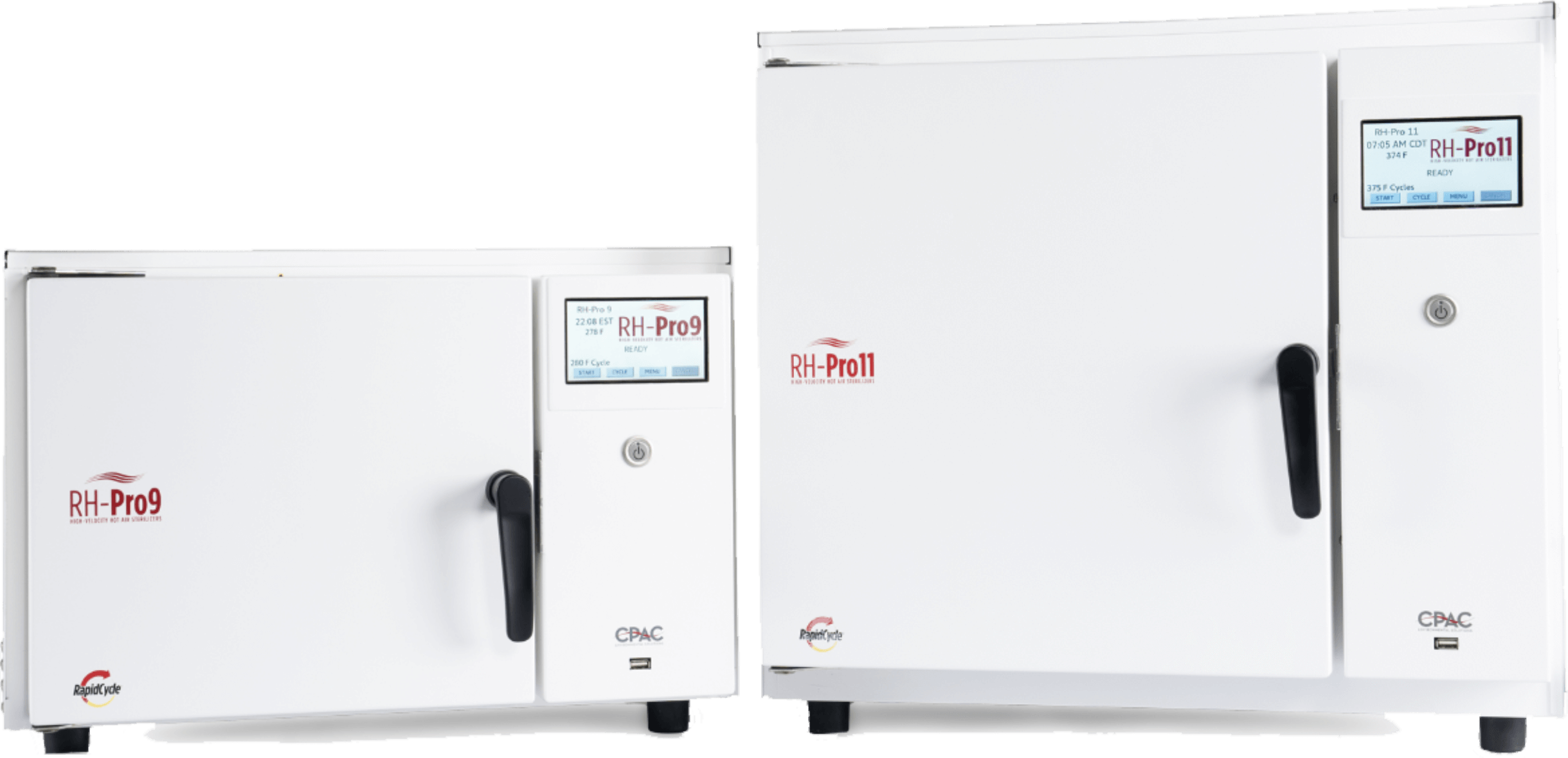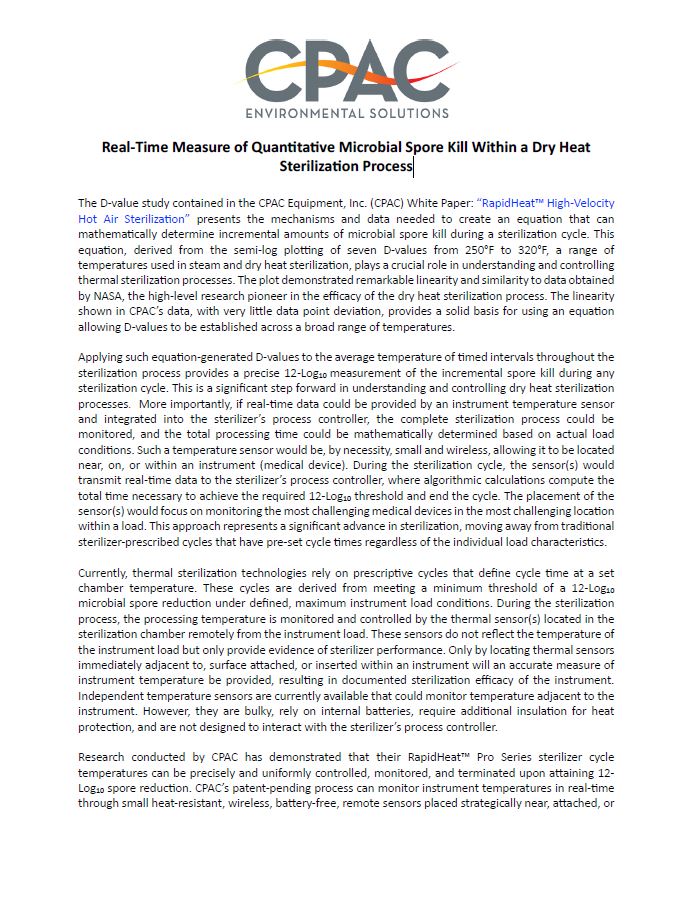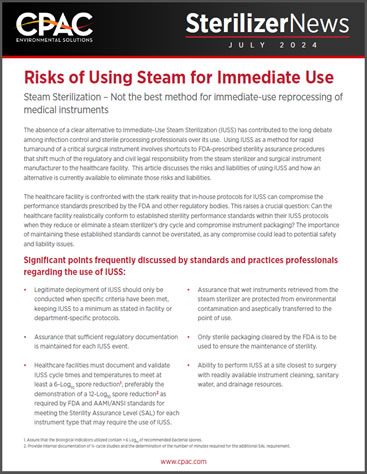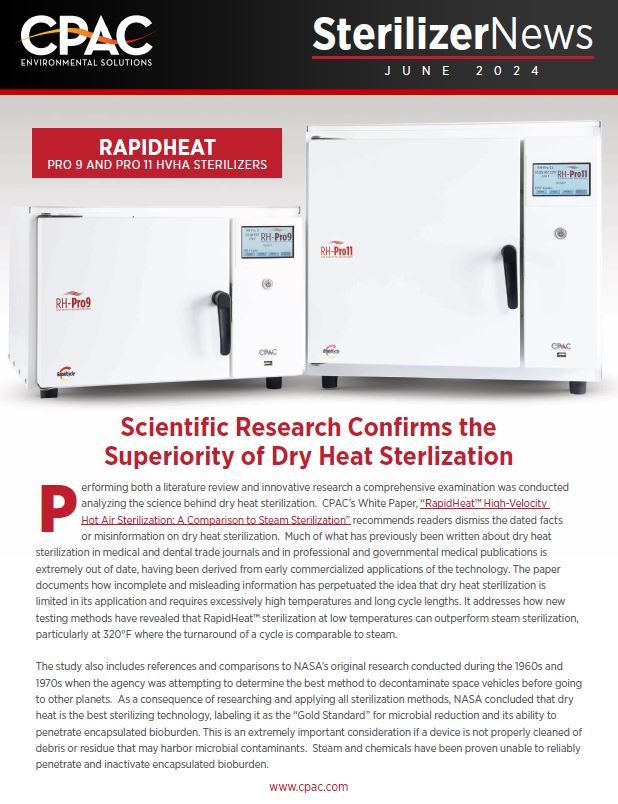We have done business with CPAC for years. When our last sterilizer went down and we were looking for a new one. The RH-Pro 11 was brand new to the market. There are no regrets on making this purchase. This office has nothing but high regard for the employees at CPAC and their equipment.

The Recognized Gold Standard in Thermal Sterilization
This technology evolved from NASA’s early research to discover the best efficacious and non-destructive decontamination technology for spacecraft.
RapidHeat offers healthcare providers a faster, waterless, chemical free, low maintenance alternative in the sterile processing of medical and dental instruments.
RapidHeat sterilization technology utilizes an advanced proprietary form of circulating “High-Velocity Hot Air” (HVHA) in a sealed chamber at the rate of 200-300 air exchanges per minute. Due to the uniform distribution of HVHA, a RapidHeat sterilizer can process wrapped or unwrapped medical and dental instrumentation with greater
efficiency in as little as 14-21 minutes total processing time to achieve a 12-Log spore kill. To accommodate the processing of temperature-sensitive items, RapidHeat sterilization technology has been recently advanced to incorporate “Low-Temperature” sterilization cycles with processing times equivalent to steam sterilizers.
Health Care Applications
RapidHeat Sterilizers Offer More Versatility!
RH-Pro line of sterilizers feature multiple cycle options, including new low temperature cycles complementing RapidHeat’s traditional 375-degree cycle. These cycle options add significant versatility to any practice’s sterilization process!

The Industry’s Most Efficient High-Capacity Table-top Sterilizers
A proven advancement in “RapidCycle” sterilization, RapidHeat sterilizers raise the level of sterilization efficiency. Using cutting-edge HVHA technology, RH-Pro sterilizers provide the fastest instrument turnaround of any FDA-Cleared sterilization technology.
Award Winning Technology
The RH-Pro11 is the 2021 Dental Advisor Top Award Winner for the Lab Performer: Sterilizer category. Learn more about how our RapidCycle sterilization stacks up against traditional steam sterilizers.
Our RapidHeat Sterilizers:
Product Categories
What Do Our Customers Say?
The superior speed of the RapidHeat sterilizer turns instruments around quickly so we can avoid the cost of extra sets. The 3-year warranty is definitely a bonus! I am very happy with this purchase.
When researching sterilizers for a new office, I decided on the RH-Pro11 sterilizer. The extra-large capacity makes processing instruments fast and easy, which is needed with the amount of patients we see a day. Very efficient and very quiet operation. I am more than pleased with the decision to purchase!
As a very busy practice we purchased the RapidHeat sterilizer to save time in processing instruments. With no water, rust inhibitors, or chemicals needed we save both time and money! Very happy with our decision!
The ease of use and quick, dependable processing of instruments helps keep our office on schedule.
The COX RapidHeat Sterilizer is so easy to use and provides complete sterilization cycles in 6 minutes with little or no maintenance.
The superior speed of the RapidHeat sterilizer turns instruments around quickly so we can avoid the cost of extra sets. The 3-year warranty is definitely a bonus! I am very happy with this purchase.
FAQs
Yes, CPAC Equipment, Inc. is an FDA registered facility #2431273 and FDA has previously received clearance for the RapidHeat sterilization technology under 510(k) #K872643A and #K881371.
RapidHeat sterilizers have been in successful use for over 25 years by dental and healthcare practices.
Yes, with the advancements made in the construction and components of modern instrumentation, most instruments including handpieces with very few exceptions can now be processed with no deleterious impact on an instrument’s life-cycle. For those instruments that are suspect or determined not to be sterilizable at RapidHeat’s high cycle temperature cycle, we have introduced a new low temperature option that is comparable to the autoclave temperatures.
Yes, RapidHeat sterilizers have pre-set sterilization cycles ranging from six minutes to twenty-one minutes depending on load configuration, packing configuration, and load size. These short sterilization cycle times and no drying requirement makes HVHA technology an excellent choice to replace “Immediate-Use steam sterilization.” RapidHeat Sterilizer cycles do not fall under healthcare’s definition of “immediate-use” which is a standard term used for short-cutting the drying time needed in steam sterilization. An “Immediate-Use” steam sterilization cycle is used by staff when an instrument or instrument set has an emergency need to be turned around as quickly as possible. If there is improper drying, subsequent cooling will cause any moisture to condense and packaged instruments to remain wet, increasing the potential for instrument corrosion. Moisture degrades the ability of the packaging to maintain sterility. Failure to dry instruments after steam sterilization violates CDC’s recommendations that state “instrument packs should be allowed to dry inside the sterilizer chamber before removing and handling. Packs should not be touched until they are cool and dry because hot packs act as wicks, absorbing moisture, and hence, bacteria from hands.”
A Comparative Cost Analysis reveals that a practice can achieve at least a 50% operating cost savings over a comparable steam sterilizer. The greatest savings are found in maintenance and repairs, utilities, and the cost of instrument replacement caused by corrosion from steam exposure.
News
View all our white papers, articles, News Releases, and What’s New in terms of trade shows and other meetings.









